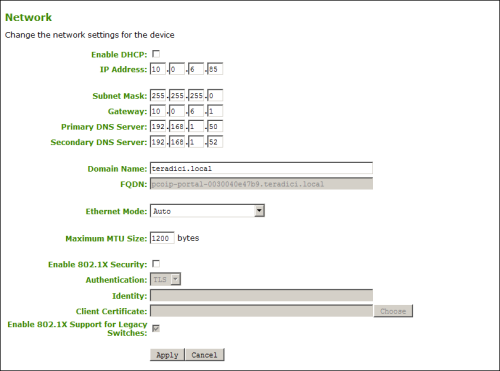
This page lets you configure network settings for the client. You can access this page from the Configuration > Network menu. After you update the parameters on this page, click Apply to save your changes.
Note: You can also configure network information from the client's Initial Setup page.

AWI Network Page
AWI Network Page Parameters
| Parameter | Description |
|---|---|
|
Enable DHCP |
When enabled, the device contacts a DHCP server to be assigned an IP address, subnet mask, gateway IP address, and DNS servers, and also requests a domain name (option 15), host name (option 12), and client fully qualified domain name (FQDN). When disabled, you must set these parameters manually. |
|
IP Address |
The device's IP address. If DHCP is disabled, you must set this field to a valid IP address. If DHCP is enabled, you cannot edit this field. |
|
Subnet Mask |
The device's subnet mask. If DHCP is disabled, you must set this field to a valid subnet mask. If DHCP is enabled, you cannot edit this field. Warning: It is possible to configure an illegal IP address/subnet mask combination (e.g., invalid mask) that leaves the device unreachable. Take care when setting the subnet mask. |
|
Gateway |
The device's gateway IP address. If DHCP is disabled, this field is required. If DHCP is enabled, you cannot edit this field. |
|
Primary DNS Server |
The device's primary DNS IP address. This field is optional. If the DNS server IP address is configured when using a connection manager, the connection manager address may be set as an FQDN instead of an IP address. |
|
Secondary DNS Server |
The device's secondary DNS IP address. This field is optional. If the DNS server IP address is configured when using a connection manager, the connection manager address may be set as an FQDN instead of an IP address. |
|
Domain Name |
The domain named of the device (e.g., "domain.local"). This field is optional. |
|
FQDN |
The fully qualified domain name for the device. The default is pcoip-host-<MAC> or pcoip-portal-<MAC> where <MAC> is the device's MAC address. If used, the domain name is appended (for example, pcoip-host-<MAC>.domain.local). This field is read-only on this page. Note: To use the FQDN feature, the DNS server with DHCP option 81 must be available and properly configured. |
|
Ethernet Mode |
Lets you configure the Ethernet mode of the device as follows:
When you choose 10 Mbps Full Duplex or 100 Mbps Full-Duplex and then click Apply, the following warning message appears: "Warning: When Auto-Negotiation is disabled on the PCoIP device, it must also be disabled on the switch. Additionally, the PCoIP device and switch must be configured to use the same speed and duplex parameters. Different parameters may result in a loss of network connectivity. Are you sure you want to continue?" Click OK to change the parameter. Note: You should always set the Ethernet mode to Auto and only use 10 Mbps Full-Duplex or 100 Mbps Full-Duplex when the other network equipment (e.g., a switch) is also configured to operate at 10 Mbps full-duplex or 100 Mbps full-duplex. An improperly set Ethernet mode may result in the network operating at half-duplex, which is not supported by the PCoIP protocol. The session will be severely degraded and eventually dropped. |
|
Lets you configure the Maximum Transfer Unit packet size. A smaller MTU may be needed for situations such as VPN tunneling because PCoIP packets cannot be fragmented. Set the Maximum MTU Size to a value smaller than the network path MTU for the end-to-end connection between the host and client. The Maximum MTU Size range is 600 to 1500 bytes for all firmware versions. The default MTU size is 1200. |
|
|
Enable 802.1X Security |
Enable this field for each of your devices if your network uses 802.1x security to ensure that only authorized devices access the network. If enabled, configure the Authentication, Identity, and Client Certificate fields. |
|
Authentication |
This field is set to TLS (Transport Layer Security) and is grayed-out. TLS is currently the only authentication protocol supported. |
|
Identity |
Enter the identity string used to identify your device to the network. |
|
Client Certificate |
Click Choose to select the client certificate you want to use for your 802.1x devices. The list of certificates that appears includes the certificates uploaded from the Certificate Upload page that contain a private key. The certificate you choose from the Network page is linked to the read-only Client Certificate field on the Certificate Upload page. Note: PCoIP only supports one 802.1x client certificate. Ensure your security details are all contained within the one file. The 802.1x certificate must contain a private key. |
|
Enable 802.1X Support for Legacy Switches |
When enabled, allows greater 802.1x compatability for older switches on the network. |